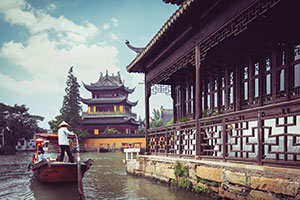With our outstanding native-born guides, this Original Journey takes you deeper inside the culture and history of these inspiring lands. Warm personal encounters, feeding Pandas and our exclusive Touch Antiquity experience make this a truly special trip. We even include a full program of shore excursions for your Yangtze cruise aboard China's finest all-balcony river ship.
Yangtze River
Yangtze River
The Yangtze is the longest Asian river, about 3,400 mi long. It rises in the Kunlun Mountains in Qinghai (Tsinghai) Province, and flows to its mouth in the East China Sea, about 14 miles north of Shanghai. Ocean-going vessels may navigate the river to Hankou, a distance of almost 600 miles from the sea. For about 200 miles inland from its mouth, the river is virtually at sea level. The delta flows through Jiangsu Province, largely a deltaic plain consisting of silt deposited by the Yangtze and one of the chief rice-growing areas of China.
|
Destination Guide
|
Lhasa
Lhasa
Lhasa is the capital of the autonomous region of Tibet, located in southwestern China. The city's most famous attraction is the Potala, the former residence of the Dali Lama. It is an impressive palace built on a ridge overlooking the city. Rich in history, some of it very recent by the region's standards, Lhasa was occupied by the Chinese Communists in 1951. It was in 1959 that the Dali Lama fled the country, thus marking the beginning of the 'Free Tibet' movement. Many of the religious and cultural treasuers were damaged or destroyed in the late 60's during the Cultural Revolution, but many of Lhasa's treasures still remain.
|
Destination Guide
|
Chengdu
Chengdu
The main inland access city to Tibet, Chengdu is the capital of the "Heavenly State". Most known for its natural habitat and research center for giant pandas, this sprawling city boasts a population of over 11 million.
|
Destination Guide
|
Xi'an
Xi'an
Xi'an - with five million inhabitants and capital of Shaanxi Province - is one of the more pleasant of Chinese cities, more prosperous than any other city in inland China except Chengdu, with streets full of Japanese cars, stores flooded with temptations, and stylish locals in new discos. It's far richer than the surrounding area, a fact which becomes clear after a bus ride into surrounding plains. The city is also a primer in Chinese history, as between 1000 BC and 1000 AD it served as imperial capital for eleven dynasties. Find a wealth of important sites and relics hereabouts: Neolithic Banpo, the Terracotta Army of the Qin emperor, the Han and Tang imperial tombs, and in the city itself, the Goose Pagodas of the Tang, the Bell and Drum towers and Ming city walls, as well as two museums holding a treasury of relics from the most glamorous parts of Chinese history. The city is very popular with foreign residents, and many come to study, as the colleges are regarded as some of the best places to learn Chinese.
|
Destination Guide
|
Beijing
Beijing
Beijing is the country's economic, cultural and transportation center as well as a famous historical capital of China. Located in northwest North China Plain, Beijing is the second largest city in China with a population of more than 11 million and is ideal to visit all year. There are numerous museums and libraries with the largest collection of books in the country. It also serves as a center for science and technology. It is a hub of communications, with good railroad and air links with all parts of China and with major cities of the world, thus facilitating the rapid development of tourism as an important industry in Beijing. Beijing is an ancient city with a long cultural history. The four feudal dynasties--Jin, Yuan, Ming, and Qing had all set up their capital here and it became a most concentrated place of the country's scenic spots and historical sites. The best known are the Palace Museum, the Summer Palace, the Great Wall and the Temple of Heaven. Beijing aims to develop into a modern international metropolis..
|
Destination Guide
|
Shanghai
Shanghai
Shanghai is a teeming metropolis of 11 million, bustling with energy, towering skyscrapers, art deco buildings, honking traffic, and shopping crowds. Once here, visitors will find Eastern ways abound: Tai Chi along the Bund, the serenity of exquisite ponds and gardens, and an endless flotilla of sampans edging along the Huangpu River. Explore Shanghai old and new: the busy bazaars and alleyways of the Old Town, Yu Garden, Wuxingting Tea House, Long Hua Temple and more.
|
Destination Guide
|






